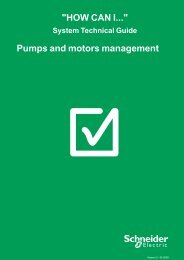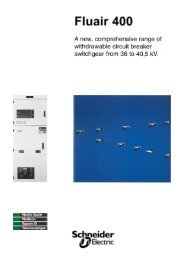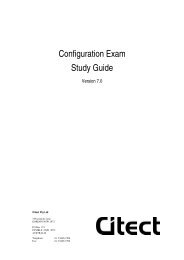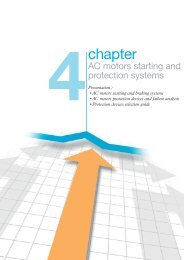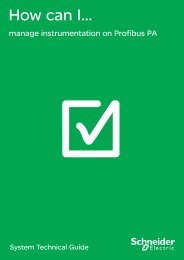Connect - Schneider Electric
Connect - Schneider Electric
Connect - Schneider Electric
Create successful ePaper yourself
Turn your PDF publications into a flip-book with our unique Google optimized e-Paper software.
Valuation of stock grants<br />
In accordance with the accounting policies described in note 1.20,<br />
the stock grant plans have been valued on the basis of an average<br />
CONSOLIDATED FINANCIAL STATEMENTS<br />
NOTES TO THE CONSOLIDATED FINANCIAL<br />
estimated life of between four and fi ve years using the following<br />
assumptions:<br />
• a payout rate of between 3.0% and 4.5%;<br />
• a discount rate of between 1.6% and 4.5%, corresponding to a<br />
risk-free rate over the life of the plans (source: Bloomberg).<br />
Based on these assumptions, the amount recorded under “Selling, general and administrative expenses” for stock grant plans set up after<br />
November 7, 2002 breaks down as follows:<br />
2011 2010<br />
Plan 5 2 2<br />
Plan 6 2 2<br />
Plan 7 - -<br />
Plan 8 5 5<br />
Plan 9 6 6<br />
Plan 10 16 1<br />
Plan 11 13 -<br />
Plan 10 bis - -<br />
Plan 11 bis - -<br />
Plan 12 - -<br />
Plan 13 - -<br />
Plan 14 - -<br />
TOTAL 44 16<br />
21.5.2 Worldwide Employee Stock Purchase Plan<br />
<strong>Schneider</strong> <strong>Electric</strong> gives its employees the opportunity to become<br />
group shareholders thanks to employee share issues. Employees<br />
in countries that meet legal and fi scal requirements have the choice<br />
between a classic and a leveraged plan.<br />
Under the classic plan, employees may purchase<br />
<strong>Schneider</strong> <strong>Electric</strong> shares at a 15% to 20% discount to the price<br />
quoted for the shares on the stock market. Employees must then<br />
hold their shares for fi ve years, except in certain cases provided for<br />
by law. The share-based payment expense recorded in accordance<br />
with IFRS 2 is measured by reference to the fair value of the<br />
discount on the locked-up shares. The lock-up cost is determined<br />
on the basis of a two-step strategy that involves fi rst selling the<br />
locked- up shares on the forward market and then purchasing the<br />
same number of shares on the spot market (i.e., shares that may be<br />
sold at any time) using a bullet loan.<br />
This strategy is designed to refl ect the cost the employee would<br />
incur during the lock-up period to avoid the risk of carrying the<br />
shares subscribed under the classic plan. The borrowing cost<br />
corresponds to the cost of borrowing for the employees concerned,<br />
as they are the sole potential buyers in this market. It is based<br />
on the average interest rate charged by banks for an ordinary,<br />
non- revolving personal loan with a maximum maturity of fi ve years<br />
granted to an individual with an average credit rating.<br />
Under the leveraged plan, employees may also purchase<br />
<strong>Schneider</strong> <strong>Electric</strong> shares at a 15% to 20% discount from the price<br />
quoted on the stock market. However, the leveraged plan offers a<br />
different yield profi le as a third-party bank tops up the employee’s<br />
initial investment, essentially multiplying the amount paid by the<br />
employee. The total is invested in <strong>Schneider</strong> <strong>Electric</strong> shares at a<br />
preferential price. The bank converts the discount transferred by<br />
the employee into funds with a view to securing the yield for the<br />
employee and increasing the indexation on a leveraged number<br />
(factor of 4.4 in 2010) of directly subscribed shares.<br />
As with the classic plan, the share-based payment expense is<br />
determined by reference to the fair value of the discount on the<br />
locked-up shares (see above). In addition, it includes the value of the<br />
benefi t corresponding to the issuer’s involvement in the plan, which<br />
means that employees have access to share prices with a volatility<br />
profi le adapted to institutional investors rather than to the prices and<br />
volatility profi le they would have been offered if they had purchased<br />
the shares through their retail banks. The volatility differential is<br />
treated as a discount equivalent that refl ects the opportunity gain<br />
offered to employees under the leveraged plan.<br />
As regards the fi rst semester 2011, <strong>Schneider</strong> <strong>Electric</strong> gave<br />
its employees the opportunity to purchase shares at a price of<br />
EUR95.38 or EUR89.77 per share, depending on the country, as<br />
part of its commitment to employee share ownership, on June 6,<br />
2011. This represented a 15% to 20% discount to the reference<br />
price of EUR112.21 calculated as the average opening price<br />
quoted for the share during the 20 days preceding the Management<br />
Board’s decision to launch the employee share issue.<br />
Altogether, 1.9 million shares were subscribed, increasing the<br />
Company’s capital by EUR178 million as of July 12, 2011. The issue<br />
represented a total cost of EUR9 million, taking into account the<br />
fi ve-year lock-up period.<br />
2011 REGISTRATION DOCUMENT SCHNEIDER ELECTRIC<br />
187<br />
5




